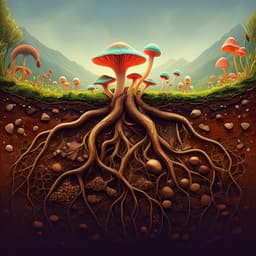
Agriculture
Effect of foliar and soil application of plant growth promoting bacteria on growth, physiology, yield and seed quality of maize under Mediterranean conditions
A. Efthimiadou, N. Katsenios, et al.
Discover how plant growth-promoting bacteria (PGPB) can enhance maize growth and yield! This exciting research by Aspasia Efthimiadou, Nikolaos Katsenios, Sofia Chanioti, Marianna Giannoglou, Nikola Djordjevic, and George Katsaros reveals significant improvements in maize cultivation through innovative bacterial biostimulants and application techniques.
~3 min • Beginner • English
Introduction
Plant growth promoting bacteria (PGPB) have been increasingly studied as sustainable biostimulants capable of enhancing plant growth, yield, and quality. PGPB can produce growth regulators, fix nitrogen, antagonize phytopathogens, solubilize mineral phosphates, interact with plant signaling, and mitigate abiotic stress responses. Their effectiveness can depend on strain origins, with indigenous strains often outperforming non-indigenous ones under local conditions. PGPB can be applied via foliar sprays or soil/seed inoculation, but the relative efficacy of these methods, particularly under Mediterranean conditions, is not fully resolved. This study aimed to evaluate three PGPB (Azotobacter chroococcum, Bacillus subtilis, Bacillus megatherium) and two mixes of them, applied foliar or to soil, on maize growth, physiology, yield, and seed quality under Mediterranean field conditions.
Literature Review
Prior work has shown numerous PGPB genera (e.g., Arthrobacter, Acinetobacter, Enterobacter, Ochrobactrum, Pseudomonas, Rhodococcus, Bacillus) can enhance plant performance via hormone modulation, N2 fixation, volatile organic compounds, nutrient availability, and stress tolerance. Indigenous strains can be more effective due to environmental adaptation. Foliar applications have improved growth and yield in crops such as wheat, mulberry, apple, and canola, though leaf-surface interactions remain less understood. Soil/seed inoculation with Azotobacter, Azospirillum, and Bacillus has improved physiology, growth, yield, and stress tolerance (e.g., salinity in maize). Other biostimulants (seaweed extracts, amino acids, microalgae) have increased protein and crude fiber in seeds. However, evidence on PGPB effects on harvested product nutritional quality remains limited, motivating evaluation in maize, a globally important cereal.
Methodology
Experimental site: Field trial at Oropos, Attica, Greece (38°18′N, 23°45′E; 45 m asl) from April–August 2019 in Mediterranean conditions. Maize hybrid Zea mays GW 8002 sown April 21, 2019. Design: Completely randomized design, 2×6 factorial with three replications. Factors: (1) Application method (foliar vs soil), (2) PGPB: Azotobacter chroococcum (Strain B002; pH 6.7; 4×10^9 CFU/mL; auxin 35.6 ppm), Bacillus subtilis (B004; pH 6.4; 7×10^9 CFU/mL; auxin 30 ppm), Bacillus megatherium (A004; pH 7.2; 6.4×10^9 CFU/mL; auxin 24 ppm), Mix A (A. chroococcum + B. subtilis 1:1 v/v), Mix B (A. chroococcum + B. megatherium 1:1 v/v), and untreated control. Plot size: 12 m^2; 75 cm row spacing. PGPB application rate: 7 L/ha once at 40 DAS; solutions diluted 1:100 in tap water to ~10^7 CFU/mL. Foliar sprays used droplet size to minimize runoff; soil applications targeted planting rows near plants. Soil characterization (0–30 cm) shortly before sowing showed clay loam, pH 7.5, adequate macro- and micronutrients (e.g., OM 5.5%, available P 99 mg/kg, K 1.1 cmol+/kg). Bacterial cultivation: Strains isolated from maize-cultivated soil, identified by 16S rDNA. Bacillus spp. grown in TSB (32 °C, 200 rpm, 48 h), A. chroococcum in Azotobacter medium (30 °C, 180 rpm, 72 h). Growth, pH, and auxin production verified colorimetrically; mixes prepared 1:1. Measurements: Growth and physiology at 52, 72, 88 DAS. - Chlorophyll (SPAD), photosynthetic rate (µmol CO2 m^-2 s^-1), transpiration (mmol H2O m^-2 s^-1), stomatal conductance (mol m^-2 s^-1) measured midday on fully expanded leaves using SPAD meter and LCi Leaf Chamber Analysis System; three measurements per plot. - Shoot dry weight: destructive sampling (3 plants/plot), oven-dried at 70 °C for 3 days. Yield: harvested Aug 20, 2019 (122 DAS); 10 plants/plot; moisture-adjusted to 15% using a portable humidity meter. Seed quality: After shade-drying (moisture ~8% w/w), measured geometric mean diameter (size) and sphericity from tri-axial dimensions; texture (hardness) via puncture probe (5 mm) using HD-Plus analyzer at controlled speeds (pre 2 mm/s, test 1 mm/s, post 10 mm/s) at 25±1 °C. Chemical analyses on ground seed flour: total solids (AOAC 925.09), crude fiber (AOAC 984.04; acid and alkali digestion followed by drying and ashing), protein (Kjeldahl AOAC 920.87; digestion at 400 °C, distillation into boric acid, titration with 0.5 M HCl). Statistics: Two-way ANOVA (factors: application method, PGPB) using IBM SPSS v24; mean separation by Duncan’s test at p≤0.05. Interactions tested (method×PGPB).
Key Findings
- PGPB and application method significantly affected most growth, physiological, yield, and quality parameters; significant interactions observed for photosynthetic rate at 72 DAS, yield, and total solids (ANOVA F values reported). Growth and physiology: - Chlorophyll content (SPAD): A. chroococcum and Mix A yielded highest values at 88 DAS (60.19 and 60.67 vs control 57.16), increases up to 6.1%. Soil application increased SPAD vs foliar at all times (e.g., 61.16 vs 57.83 at 72 DAS). - Dry weight (g plant^-1): At 88 DAS, all PGPB except Mix A exceeded control (512.50 g); highest with A. chroococcum 609.33 g, B. megatherium 598.95 g, Mix B 597.38 g. Soil application > foliar (597.11 vs 540.19 g at 88 DAS). PGPB increased dry weight by 5.1–18.9% over control at 88 DAS. - Photosynthetic rate (µmol CO2 m^-2 s^-1): At 52 DAS, all PGPB > control (e.g., Mix B 28.56 vs control 21.74); A. chroococcum increased up to 18.4% vs control. At 72 DAS, PGPB > control (Mix B 37.36; B. subtilis 37.10 vs control 31.80). At 88 DAS, B. megatherium highest (34.96) vs control 30.65. Soil application consistently higher than foliar (e.g., 37.54 vs 33.61 at 72 DAS). - Transpiration rate (mmol H2O m^-2 s^-1): At 52 DAS, A. chroococcum highest (3.41) vs control 2.54 (+34.3%). Soil application > foliar at 52 and 88 DAS. - Stomatal conductance (mol m^-2 s^-1): Significant effects at 52 and 88 DAS for PGPB and at all dates for application. At 88 DAS, B. subtilis 0.337, Mix A 0.332, Mix B 0.327, A. chroococcum 0.315 vs control 0.265; soil application > foliar at all times (e.g., 0.324 vs 0.292 at 88 DAS). Yield: - Significant interaction of PGPB×application. Highest yields with soil-applied B. megatherium (244.67 g plant^-1) and soil-applied Mix A (A. chroococcum + B. subtilis, 243.67), not different from soil-applied B. subtilis (237.33). Soil-applied Mix B 229.33 and A. chroococcum 227.33 exceeded soil control 215.67. Foliar PGPB treatments did not exceed foliar control (217.46). - Soil application increased yield by 5.5–13.4% vs control; foliar application did not improve yield under these Mediterranean conditions. Seed quality: - Total solids (%) showed significant interaction: Foliar B. subtilis 2.86% and Soil A. chroococcum 2.78% were highest; Foliar B. subtilis increased total solids by ~92% vs foliar control (1.49%). - Protein (%): Highest in control 9.99%, B. subtilis 9.85%, A. chroococcum 9.52%, and Mix B 9.24%; others lower (p<0.05). - Crude fiber (%): Highest with B. subtilis 4.73% and A. chroococcum 4.45%, increases of ~46% and ~32% vs control (3.24%). Foliar application increased crude fiber vs soil application. - No significant differences in texture (hardness), size (geometric mean diameter), or sphericity among treatments.
Discussion
The study demonstrates that PGPB can enhance maize physiological performance (chlorophyll, photosynthesis, stomatal conductance) and biomass, translating into higher yields when applied to soil. The strongest yield responses occurred with soil-applied B. megatherium and the A. chroococcum + B. subtilis mix, indicating that certain strains and consortia are particularly effective in the rhizosphere. Physiological improvements, including higher photosynthetic rates and stomatal conductance, likely underpin yield gains via improved carbon assimilation and water relations. Soil application consistently outperformed foliar application across growth and physiological metrics and yield, suggesting superior bacterial establishment, persistence, and plant–microbe interaction in the soil/root zone compared to phyllosphere applications under Mediterranean conditions. Quality outcomes show that PGPB can improve nutritional attributes: B. subtilis notably increased total solids and crude fiber, while protein content remained high in several treatments (including control). Importantly, improvements in chemical quality occurred without adverse changes in physical grain properties (size, sphericity, texture), which is favorable for downstream handling and processing. These findings support PGPB as practical biostimulants to improve maize productivity and seed quality, with application method being a critical determinant of efficacy.
Conclusion
PGPB species (Azotobacter chroococcum, Bacillus subtilis, Bacillus megatherium) and their mixes significantly influenced maize growth, physiology, yield, and seed quality. Soil application consistently enhanced chlorophyll, dry weight, photosynthetic rate, transpiration, and stomatal conductance relative to foliar application. The largest yield gains were achieved with soil-applied B. megatherium and the A. chroococcum + B. subtilis (1:1) mix. Quality improvements included substantial increases in total solids and crude fiber, particularly with B. subtilis, without affecting grain physical properties. The study supports PGPB use as biostimulants for sustainable maize production in Mediterranean environments. Future work should elucidate mechanisms of action and optimize biostimulant parameters (strain selection, dosage, timing, frequency, and application method) across different crops and environments to develop robust agronomic recommendations.
Limitations
- Single location and growing season under specific Mediterranean conditions limit generalizability to other climates or seasons. - One maize hybrid (GW 8002) was tested; responses may vary with genotype. - Single application timing (40 DAS), dose (7 L/ha; ~10^7 CFU/mL), and single application event were used; alternative regimes were not evaluated. - Foliar application efficacy may depend on environmental conditions (e.g., humidity, leaf wetness) not systematically varied. - Mechanistic assessments (e.g., colonization dynamics, hormone levels, nutrient uptake) were not conducted. - Indigenous strains were used; comparisons with non-indigenous or additional consortia were not included.
Related Publications
Explore these studies to deepen your understanding of the subject.







